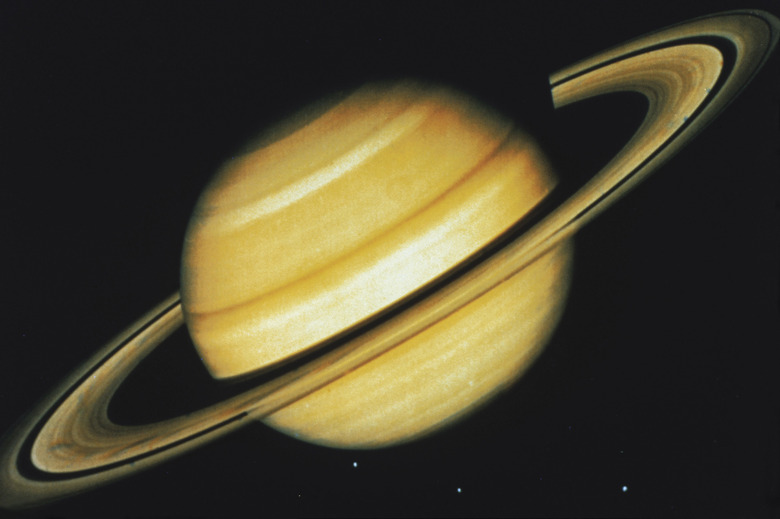Life On The Planet Saturn
The planet Saturn boasts the most spectacular ring system in the solar system — the product of billions of ice particles traveling in an orbital plane. Saturn also has a robust collection of satellites circling it. Recent studies have focused on these moons as potential hosts for extraterrestrial life. Indeed, the data compiled by space probes have shocked scientists, showing moons with dense atmospheres, hydrocarbon seas and active volcanism, all of which may have the potential to nurture life.
Saturn
Saturn
The second largest planet in the solar system, Saturn is composed mainly of gases such as hydrogen and helium, with only a hint of water ice in its lower clouds. The temperature of Saturn's clouds are approximately negative 150 degrees Celsius (negative 238 degrees Fahrenheit), but the temperature increases as you go lower within the atmosphere. The low levels of water and the huge pressures found there make it unlikely for life to exist within the planet itself.
A Hostile Environment for Life
A Hostile Environment for Life
Hydrocarbon molecules, dissolved in liquid water, form the basis of life on Earth. Scientists believe that these two ingredients are essential to life, and they use such criteria when searching for life on other bodies within the solar system. Saturn's core consists of liquid hydrogen, molten rock and melted ice. Although there is melted ice, the pressure near the core is estimated to be 5 million atmospheres (5,066,250 bar), which is beyond the pressure that can be tolerated by any known extremophile (organism that lives in an extreme environment).
Saturn has only trace amounts of water in its atmosphere, and these are tied up within clouds in the upper atmosphere. The temperatures in these clouds are estimated to be negative 20 degrees Celsius (minus 4 degrees Fahrenheit), and the pressure is approximately 7.9 atmospheres (8 bar). These conditions may be tolerable to life, since bacteria on Earth have been found living in ice. Even so, the lack of complex organic molecules makes life in Saturn's atmosphere unlikely.
Titan
Titan
Titan possesses the largest diameter of any of Saturn's moons and, surprisingly, is also larger than the planet Mercury. Titan's large size gives it sufficient gravity to maintain an atmosphere consisting of nitrogen and methane. A 2010 scientific study carried out by the NASA Cassini spacecraft suggests extraterrestrial life may be present on the elusive moon. Darrell Strobel of Johns Hopkins University analyzed the amount of hydrogen in Titan's atmosphere using Cassini data. The research found that hydrogen was flowing down from the atmosphere to the ground and then disappearing. This suggests that hydrogen is being used up in an unknown chemical or biological process.
Enceladus
Enceladus
One of Saturn's smaller moons, Enceladus, has been the subject of intense scientific investigation. The Cassini spacecraft made a series of close flybys past Enceladus and found jets of water erupting from a potential subterranean sea. Further analysis of the jets demonstrated that they contained salt, with a salinity similar to the oceans on Earth. Some scientists have proposed that extraterrestrial bacteria may live in the subterranean ocean and that the jets may be spewing them into space, within easy reach of a sample collection mission.
Hyperion
Hyperion
Hyperion is a small, nonuniform moon orbiting Saturn. Its size prevents it from having an atmosphere, and its surface is heavily cratered. The Cassini spacecraft has studied the composition of Hyperion's surface. It found that the surface consisted of water ice, carbon dioxide ice and small particles containing organic molecules. When exposed to ultraviolet light from the sun, these organic molecules can create biological molecules. The study suggests Hyperion may have the basic ingredients of life.
References
- Space.com: Titan, Saturn's Largest Moon, Facts and Discovery
- NASA: What is Consuming Hydrogen and Acetylene on Titan?
- NASA: Is it Snowing Microbes on Enceladus?
- Space.com: Saturn Moon Enceladus Eyed for Sample-Return Mission
- Science Daily: Hydrocarbons, Necessary For Life, Found On Saturn's Moon Hyperion
- NASA: Hyperion: Overview
- Universe Today: Is There Life on Saturn?
- Space.com: Life's Building Blocks 'Abundant in Space'
- Universe Today: Is There Water on Saturn?
Cite This Article
MLA
Markings, Samuel. "Life On The Planet Saturn" sciencing.com, https://www.sciencing.com/life-planet-saturn-5204/. 24 April 2017.
APA
Markings, Samuel. (2017, April 24). Life On The Planet Saturn. sciencing.com. Retrieved from https://www.sciencing.com/life-planet-saturn-5204/
Chicago
Markings, Samuel. Life On The Planet Saturn last modified August 30, 2022. https://www.sciencing.com/life-planet-saturn-5204/
